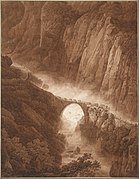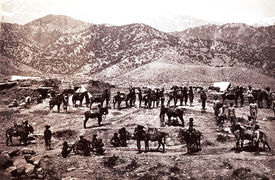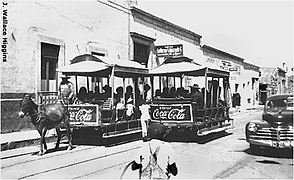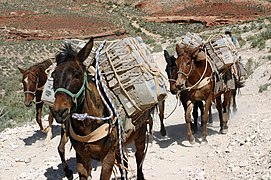Mule
| Mule | |
|---|---|
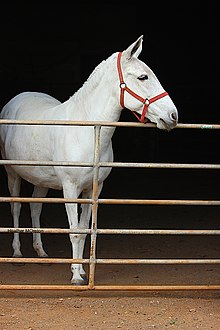
| |
Domesticated
| |
| Scientific classification | |
| Domain: | Eukaryota |
| Kingdom: | Animalia |
| Phylum: | Chordata |
| Class: | Mammalia |
| Order: | Perissodactyla |
| Family: | Equidae |
| Tribe: | Equini |
| Genus: | Equus |
| Species: | |
The mule is a
Mules vary widely in size, and may be of any color. They are more patient, hardier and longer-lived than horses, and are perceived as less obstinate and more intelligent than donkeys.[3]: 5
Terminology
A female mule that has
History

Breeding of mules became possible only when the range of the domestic horse, which originated in Central Asia in about 3500 BC, extended into that of the domestic ass, which originated in north-eastern Africa. This overlap probably occurred in Anatolia and Mesopotamia in Western Asia, and mules were bred there before 1000 BC.[5]: 37
A painting in the
Homer noted their arrival in Asia Minor in the Iliad in 800 BC.[9]
Christopher Columbus allegedly brought mules to the New World.
George Washington bred mules at his Mount Vernon home. At the time, they were not common in the United States, but Washington understood their value, as they were "more docile than donkeys and cheap to maintain."[11] In the nineteenth century, they were used in various capacities as draught animals – on farms, especially where clay made the soil slippery and sticky; pulling canal boats; and famously for pulling, often in teams of 20 or more animals, wagonloads of borax out of Death Valley, California from 1883 to 1889. The wagons were among the largest ever pulled by draught animals, designed to carry 10 short tons (9 metric tons) of borax ore at a time.[12]
Mules were used by armies to transport supplies, occasionally as mobile firing platforms for smaller cannons, and to pull heavier field guns with wheels over mountainous trails such as in Afghanistan during the Second Anglo-Afghan War.[13]
In the second half of the twentieth century, widespread use of mules declined in industrialised countries. The use of mules for farming and for transportation of agricultural products largely gave way to steam-, then diesel-powered,
Characteristics
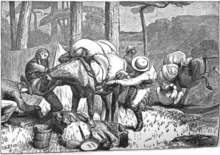
In general terms, in both the mule and the hinny, the foreparts and head of the animal are similar to those of the father
Mules vary widely in size, from small miniature mules under 125 cm (50 in) to large and powerful draught mules standing up to 180 cm (70 in) at the withers.[17]: 86 The median weight range is between about 370 and 460 kg (820 and 1000 lb).[18]
The coat may be of any color seen in the horse or in the donkey. Mules usually display the light points commonly seen in donkeys: pale or mealy areas on the belly and the insides of the thighs, on the muzzle, and around the eyes. They often have primitive markings such as dorsal stripe, shoulder stripe or zebra stripes on the legs.[5]: 37
The mule exhibits
The mule inherits from the donkey the traits of intelligence, sure-footedness, toughness, endurance, disposition, and natural cautiousness. From the horse it inherits speed, conformation, and agility.
In the early twentieth century the mule was preferred to the horse as a pack animal – its skin is harder and less sensitive than that of a horse, and it is better able to bear heavy weights.[16]
Fertility
A mule has 63
Pregnancy is rare, but can occasionally occur naturally, as well as through
A 1939 article in the Journal of Heredity describes two offspring of a fertile mare mule named "Old Bec," which was owned at the time by Texas A&M University in the late 1920s. One of the foals was a female, sired by a jack. Unlike her mother, she was sterile. The other, sired by a five-gaited Saddlebred stallion, exhibited no characteristics of any donkey. That horse, a stallion, was bred to several mares, which gave birth to live foals that showed no characteristics of the donkey.[30] In a more recent instance, a group from the Federal University of Minas Gerais in 1995 described a female mule that was pregnant for a seventh time, having previously produced two donkey sires, two foals with the typical 63 chromosomes of mules, and several horse stallions that had produced four foals. The three of the latter available for testing each bore 64 horse-like chromosomes. These foals phenotypically resembled horses, though they bore markings absent from the sire's known lineages, and one had ears noticeably longer than those typical of her sire's breed. The elder two horse-like foals had proved fertile at the time of publication, with their progeny being typical of horses.[31]
Use

While a few mules can carry live weight up to 160 kg (353 lb), the superiority of the mule becomes apparent in their additional endurance.
About 3.5 million donkeys and mules are slaughtered each year for meat worldwide.[35]
Mule trains have been part of working portions of transportation links as recently as 2005 by the World Food Programme,[36] and are still used extensively to transport cargo in rugged, roadless regions.[citation needed]
The
Gallery
-
The Devil's Bridge at Schöllenen Gorge, drawing by Peter Birmann
-
Mule train fording the Quesnel River, 1868
-
Mule battery in the Second Anglo-Afghan War, 1879–1880
-
British mule train during theSecond Anglo-Boer Warin South Africa
-
Mule train in British Columbia, 1911
-
Mule cars in Celaya, Guanajuato, Mexico, 1930s
-
Unloading US Army mules in Naples, Italy, in September, 1944
-
Ploughing with a mule, Saluda, South Carolina, 1947
-
Mules delivering mail, Supai, Arizona, 2008
-
On the South Kaibab trail in the Grand Canyon
See also
References
- ^ "Mule Day: A Local Legacy". americaslibrary.gov. Library of Congress. 18 December 2013. Archived from the original on 28 September 2020. Retrieved 22 September 2020.
- ^ "What is a mule?". The Donkey Sanctuary. Archived from the original on 1 October 2020. Retrieved 22 September 2020.
- ISBN 0-87842-499-7.
- ^ "Longear Lingo". lovelongears.com. American Donkey and Mule Society. 22 May 2013. Archived from the original on 8 January 2018. Retrieved 16 July 2014.
- ^ ISBN 9781780647944.
- ^ Tomb-painting: Museum number EA37982. London: British Museum. Archived 25 June 2020.
- ^ ISBN 0292715323.
- ^ Wall panel; relief: Museum number 124896 Archived 6 July 2022 at the Wayback Machine. London: British Museum. Accessed July 2022.
- ^ "Homer, Iliad, Book 23, line 93". perseus.tufts.edu. Archived from the original on 13 October 2022. Retrieved 12 October 2022.
mules
- ^ "Mules, mankind share a common history in modern world". The Daily Herald. Archived from the original on 2 April 2023. Retrieved 15 February 2020.
- OCLC 535490473.
- ^ "Mules hauling a 22,000lb boiler". Texas State Library and Archives Commission. Archived from the original on 2 June 2016. Retrieved 4 September 2015.
- ^ Caption of Mule Battery WDL11495.png Library of Congress
- ^ ISBN 9781444397635.
- ^ a b Constance Holden (30 May 2003). First Cloned Mule Races to Finish Line. Science. 300 (5624): 1354.
- ^ a b One or more of the preceding sentences incorporates text from a publication now in the public domain: Chisholm, Hugh, ed. (1911). "Mule". Encyclopædia Britannica. Vol. 18 (11th ed.). Cambridge University Press. pp. 959–960.
- ISBN 9780813428833.
- ^ "Mule". The Encyclopædia Britannica: A Dictionary of Arts, Sciences, and General. Vol. XVII. Henry G. Allen and Company. 1888. p. 15. Archived from the original on 2 April 2023. Retrieved 27 March 2016.
- ISBN 978-0-470-96037-0. Archivedfrom the original on 2 April 2023. Retrieved 16 July 2014.
- ^ Darwin, Charles (1879). What Mr. Darwin Saw in His Voyage Round the World in the Ship 'Beagle'. New York: Harper & Bros. pp. 33–34. Retrieved 16 July 2014.
- ISBN 978-1-62636-166-9. Retrieved 16 July 2014.
- ^ S2CID 27962537.
- ^ Giebel; et al. (1958). "Visuelles Lernvermögen bei Einhufern". Zoologische Jahrbücher. Physiologie. 67: 487–520.
- PMID 26373886.
- ^ RV, Short (1 October 1975). "The contribution of the mule to scientific thought". Journal of Reproduction and Fertility Supplement. 1 (1): 1.
- .
- ^ a b c Kay, Katty (2 October 2002). "Morocco's miracle mule". BBC News. Archived from the original on 29 July 2018. Retrieved 5 February 2009.
- National Public Radio. 26 July 2007. Archivedfrom the original on 6 December 2008. Retrieved 5 February 2009.
- ^ Denver Post. Archivedfrom the original on 7 November 2009. Retrieved 5 February 2009.
- .
- .
- ^ a b "Hunter's Specialties: More With Wayne Carlton On Elk Hunting". hunterspec.com. Hunter's Specialties. 2009. Archived from the original on 8 October 2010. Retrieved 16 July 2014.
- ^ Khan, Aamer Ahmed (19 October 2005). "Beasts ease burden of quake victims". BBC. Archived from the original on 29 April 2009. Retrieved 6 April 2010.
- ^ American Endurance Ride Conference (November 2003). "Chapter 3, Section IV: Size". Endurance Rider's Handbook. AERC. Archived from the original on 15 May 2008. Retrieved 7 August 2008.
- ^ "FAOSTAT". www.fao.org. Archived from the original on 24 February 2019. Retrieved 25 October 2019.
- ^ "Mule train provides lifeline for remote quake survivors". www.wfp.org. World Food Programme. Archived from the original on 8 December 2015. Retrieved 4 September 2015.
Further reading
- Arnold, Watson C. (2008). "The Mule: The Worker that "Can't Get No Respect"". Southwestern Historical Quarterly. 112: 34–50. from the original on 6 February 2019. Retrieved 3 January 2022.
- Buchholz, Katharina (16 August 2013). "Colorado miracle mule foal lived short life, but was well-loved". Denver Post. Archived from the original on 25 July 2014. Retrieved 16 July 2014.
- Chandley, A. C.; Clarke, C. A. (1985). "Cum mula peperit". Journal of the Royal Society of Medicine. 78 (10): 800–801. PMID 4045882.
- Ellenberg, George B. (2007). Mule South to Tractor South: Mules, Machines, and the Transformation of the Cotton South. University of Alabama Press. ISBN 9780817357726. Archivedfrom the original on 2 April 2023. Retrieved 3 January 2022.
- Loftus, Bill (August 2003). "It's a Mule: UI produces first equine clone". Here We Have Idaho: The University of Idaho Magazine. University of Idaho: 12–15. Archived from the original on 23 July 2014. Retrieved 16 July 2014.
- Lukach, Mark (11 September 2013). "There Is a Man Wandering Around California With 3 Mules". The Atlantic. Atlantic Monthly Group. Archived from the original on 24 July 2014. Retrieved 16 July 2014.
- Renner, G. K. "The Mule in Missouri Agriculture, 1821-1950." Missouri Historical Review 74 (July 1980): 433–457. online
- Rong, R.; Chandley, A. C.; Song, J.; McBeath, S.; Tan, P. P.; Bai, Q.; Speed, R. M. (1988). "A fertile mule and hinny in China". Cytogenetic and Genome Research. 47 (3): 134–9. PMID 3378453.
- Williams, John O; Speelman, Sanford R (1948). "Mule production". Farmers' Bulletin. 1341. U.S. Government Printing Office.
External links
 Media related to Mule at Wikimedia Commons
Media related to Mule at Wikimedia Commons Data related to Equus mulus at Wikispecies
Data related to Equus mulus at Wikispecies The dictionary definition of mule at Wiktionary
The dictionary definition of mule at Wiktionary

